Newsletter Signup
The Austin Monitor thanks its sponsors. Become one.
Most Popular Stories
- Austin’s airport is getting a new concourse and 20 more gates but not until the 2030s
- New rules in the works for electric vehicle charging stations
- Judge rules city can’t use taxpayer money for South Central TIRZ
- Budget deficit looms over city this year and beyond
- Save Our Springs Alliance sues City Council over Open Meetings Act
-
Discover News By District
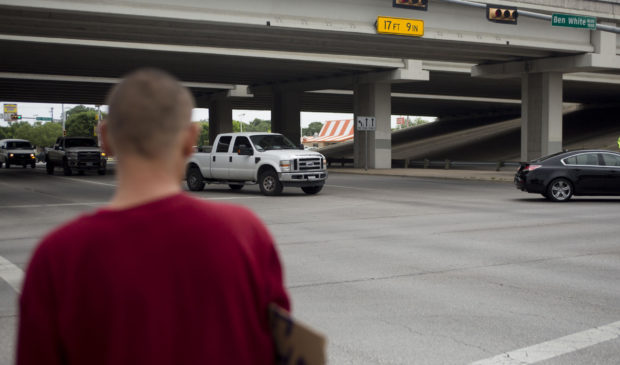
To reduce traffic deaths, Austin envisions ending homelessness
Tuesday, May 10, 2016 by Kate McGee
Robert Lormond is standing on the corner of Ben White and Manchaca watching his friend Jerry. Two police officers have stopped him.
“I called him across the street. I didn’t see a police officer and he jaywalked,” Lormond says.
There are crosswalks on three of the four sides of this intersection, but Jerry cut across the road — the one side without a crosswalk. And that’s illegal.
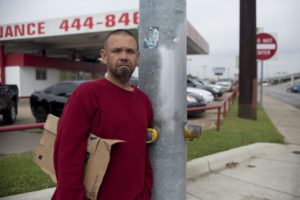
Robert Lormond, who is experiencing homelessness, stands at Ben White and Manchaca. He says he almost gets hit by a car daily.
CREDIT MIGUEL GUTIERREZ JR./ KUT NEWS
“That’s ridiculous,” Lormond says, motioning to the one part of the intersection without a crosswalk. “Why wouldn’t they have a crosswalk crossing a major intersection? This does not make any sense at all.”
Lormond is homeless, and, like many living on the streets in Austin, he spends his days on the corner of a busy intersection asking drivers for money.
Lormond says he often has near misses with cars.
“I was crossing the street,” Lormond says, recounting one near miss earlier that morning. “I had the walk signal, and a guy almost ran over my foot. He looked right at me and didn’t even slow down.”
“I’ve been hit by two cars,” says Waco, another man experiencing homelessness in Austin. You can usually find Waco sitting on a street corner off of Riverside Drive. He wouldn’t tell us his real name, but everyone knows him as Waco.
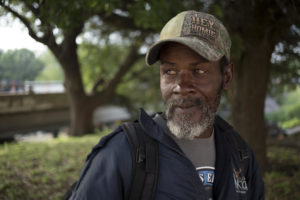
Waco, a man experiencing homelessness standing near Riverside Drive, says he has been hit by two cars in Austin.
CREDIT MIGUEL GUTIERREZ JR./ KUT NEWS
“The first time, I was in the wrong,” Waco says. “Second time, I was right.”
Waco says the first accident was at William Cannon Drive and Bluff Springs Road. He was trying to catch a bus and cut between two parked buses. He didn’t see a car driving by. The car hit him, throwing him onto the sidewalk. Waco says the second time he got hit was at Woodward Street and the I-35 frontage road. It was dark out.
“My light was green,” Waco says. “The car was coming up the access road. Hit me so hard I flew up in the air; when I came down I was in the middle of the street. And when I came down it knocked me out.”
Last year, 102 people were killed on Austin’s roads — a record number of traffic fatalities in the city. Thirty people were fatally hit by cars. More than a third of those people were experiencing homelessness, according to the Austin Police Department.
“We tend to push our individuals experiencing homelessness to sort of undesirable locations … often on a high-speed road,” says Francis Reilly, a planner for the city of Austin and one of the leaders behind the city’s Vision Zero plan, a set of recommendations to reduce traffic fatalities in the city by 2025.
“They don’t often have vehicles,” Reilly says. “They’re relying on transit and a lot of walking. Especially since they’re walking along high-speed roadways, (they) increase their risk exposure.”
Austin police say that most of the time, the homeless person is considered at fault in these crashes because they crossed midblock, which is a failure to yield to traffic, or they were drinking or on drugs. Plus, most of these accidents happen at night.
But Reilly says it’s more complicated than that.
“People who are camping maybe further out from city center and trying to catch a bus to get downtown may cross midblock and run into traffic,” Reilly says. “It’s easy to say that this is a mistake on the part of that person, but if they don’t make that bus, they don’t get services.”
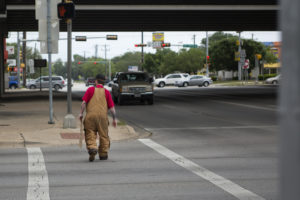
In 2015, 30 pedestrians were fatally hit by cars on Austin’s roads. Many of them were homeless. The city’s Vision Zero plan includes reducing homelessness by 2025.
CREDIT MIGUEL GUTIERREZ JR./ KUT NEWS
To curb this trend, the city’s Vision Zero plan includes goals to end homelessness entirely in Austin by 2025. The city wants to pursue Housing First models, the idea that housing is the first step toward providing stability for those living on the streets. The plan also recommends reducing the number of homeless persons being seriously hurt or killed in traffic by 25 percent per year.
Ann Howard, the executive director of the Ending Community Homelessness Coalition, says that more housing keeps more people off the streets at night.
“We want to constantly have our eye on ending the homelessness, not sort of managing it by, ‘How do we keep the folks under the bridge safe,’” Howard says. “I don’t want people under the bridge!”
In fact, Howard says she’d like to see the city end homelessness earlier than 2025.
Meanwhile, Austin police are looking for other ways to reduce pedestrian fatalities near high-speed roads. One idea is to make it illegal for people to stand on medians and shoulders near high-speed roadways.
“I don’t think any citizen or anyone would think hanging out by high-speed intersections is safe behavior,” says Art Fortune, a commander with Austin Police Highway Enforcement and a Vision Zero task force member.
But the vast majority of the pedestrian fatalities involving a homeless person happened at night, when there are few people panhandling. So it’s not clear how many deaths would be prevented by this proposal.
“A lot of times as the night goes on, we find a lot of impairment, and of course, darkness. Darkness is your enemy,” Fortune says.
David Gomez is with Austin-Travis County Integral Care, which connects with and provides services to people experiencing homelessness in Austin. He’s driving a minivan around the city to camps where homeless people live: under bridges, behind strip malls or grocery stores. Gomez says he and his team try to address safety when they visit the camps.
“There’s been discussion around when we go out to give away some of these reflective vests, and you see a lot of guys wearing those when they’re trying to clean windshields,” Gomez says.
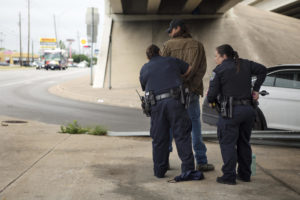
Austin Police officers arrest a man experiencing homelessness on Ben White and Manchaca. He was detained for jaywalking but arrested for an outstanding warrant for multiple tickets, including soliciting in a roadway and camping in public.
CREDIT MIGUEL GUTIERREZ JR./ KUT NEWS
Gomez brought along a bunch of zip-close bags stuffed with toiletries, called hygiene kits, in his car to hand out. He says that Integral Care has considered including reflective tape in those bags, too. Gomez says when someone living in one of these camps is hit by a car, he and his team sometimes offer emotional support to the person’s friends.
“Sometimes, sadly, when tragedy happens, it’s when people get motivated to change their lives,” Gomez says. “And it’s beneficial when we know where they are, and they know who we are and what we have to offer.”
Back on Ben White, Robert Lormond watches his friend Jerry get arrested.
Jerry had a warrant out for a variety of tickets: soliciting in a roadway, camping in public, walking in the roadway, drinking alcohol within 1,000 feet of a school.
“We have nowhere to go,” Lormond says. “Where we going to go? Go to the Arch where they all smoke crack and do everything else and sleep outside and hope to get a bed and sleep during the day? There ain’t nothing out here to help us.”
This is the second story in KUT’s series, The Road to Zero, which explores traffic deaths and injuries in Austin and the city’s plan to prevent them.
Top photo: Robert Lormand stands on the corner of Ben White and Manchaca watching his friend Jerry as he’s detained by police for jaywalking. MIGUEL GUTIERREZ JR./KUT NEWS
You're a community leader
And we’re honored you look to us for serious, in-depth news. You know a strong community needs local and dedicated watchdog reporting. We’re here for you and that won’t change. Now will you take the powerful next step and support our nonprofit news organization?









